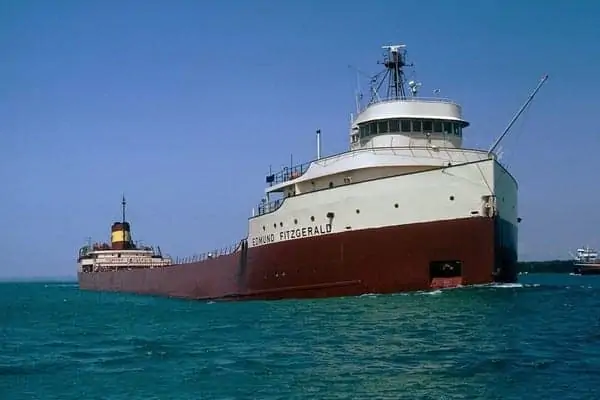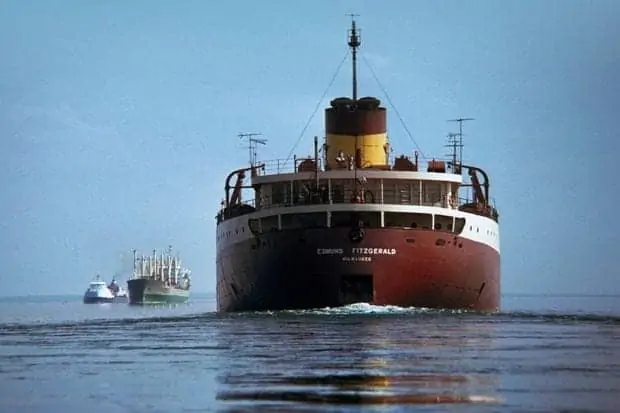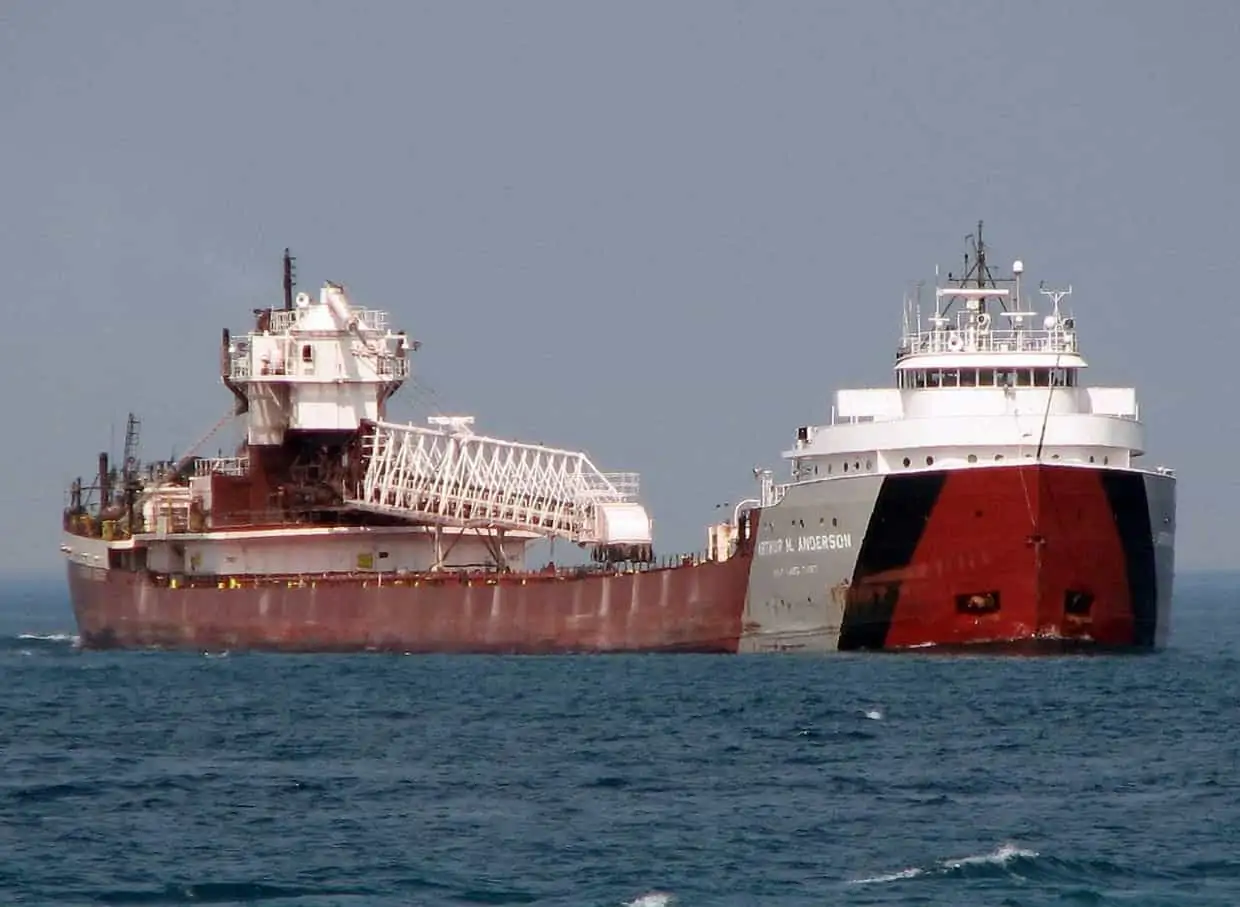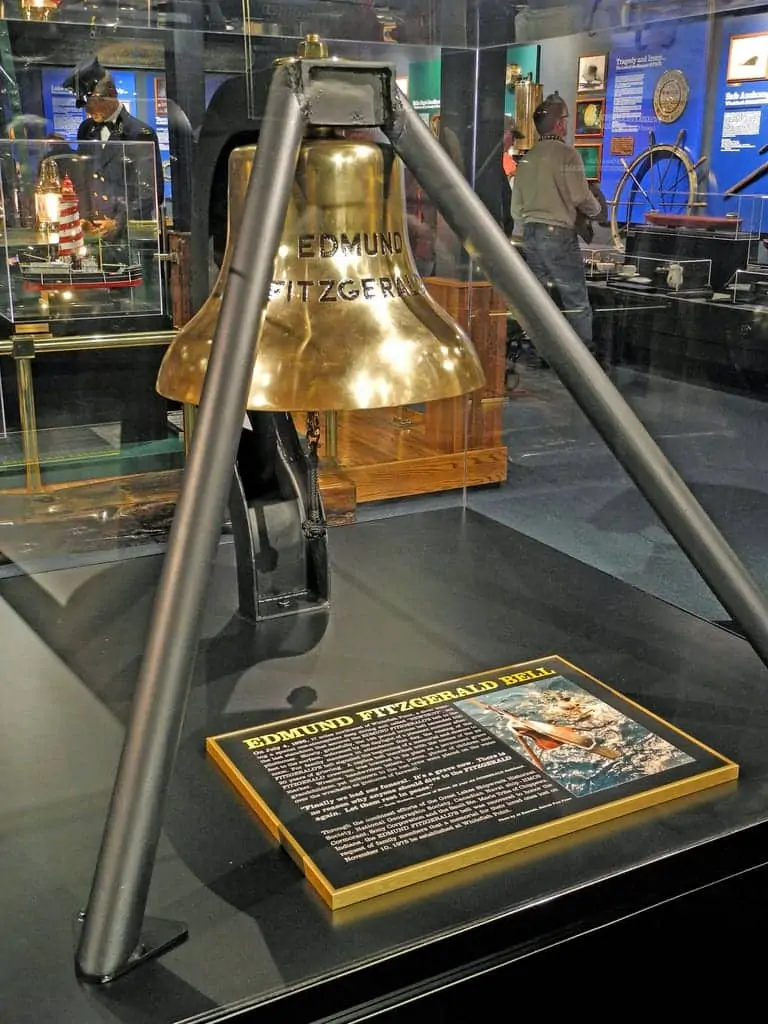 The legend lives on from the Chippewa on downOf the big lake they called Gitche GumeeThe lake, it is said, never gives up her deadWhen the skies of November turn gloomyWith a load of iron ore twenty-six thousand tons moreThan the Edmund Fitzgerald weighed emptyThat good ship and true was a bone to be chewedWhen the gales of November came early
The legend lives on from the Chippewa on downOf the big lake they called Gitche GumeeThe lake, it is said, never gives up her deadWhen the skies of November turn gloomyWith a load of iron ore twenty-six thousand tons moreThan the Edmund Fitzgerald weighed emptyThat good ship and true was a bone to be chewedWhen the gales of November came early
These iconic lyrics from the late Gordon Lightfoot song “The Wreck of the Edmund Fitzgerald” describe the last hours of one of the most famous iron ore ships to ever sail the Great Lakes. Made famous not because of her decorated career but rather due to her tragic end.
The SS Edmund Fitzgerald made history on June 7th, 1958 when it made its inaugural trip on the Great Lakes. Measuring in at 729 feet long, it was the largest ship to sail the Great Lakes at that time. She became known as the “Pride of the American Side”. Her mere existence was a sign of post-Great Depression progress for the iron ore shipping industry. Sadly, her decorated career came to a tragic end on November 10, 1975 when the great ship went down near Whitefish Point in Michigan with all 29 crew members onboard.
The Pride of Lake Superior
She was a spectacle and visitors would often flock to the Duluth Harbor to see her coming and going. Spectators simply wanted to catch a glimpse of the “giant” ship. Duluth was her home as she sailed between the Twin Ports to other port towns, primarily Detroit.
In the early years of the shipping industry, sailors learned a deep respect for the Great Lakes. As well as the storms that could suddenly erupt around them. The Mataafa Storm of 1905 and The Great Lakes Storm of 1913 both sank 11 vessels in a single day. Both storms happened in November during weather systems referred to as “The Gales of November”, which are said to “test the hulls of ships and the souls of men”.
However, by the time the SS Edmund Fitzgerald set sail, improved ship designs, modern radar navigation, reliable weather forecasting, and steady communication on the Great Lakes greatly reduced the number of shipwrecks. In fact, there hadn’t been a shipwreck on Lake Superior since 1953. At that time, two freighters collided in heavy fog near Thunder Bay, Ontario. So when the SS Edmund Fitzgerald left port on November 9th, 1975, for her last trip of the season, despite knowing of an impending storm system due to hit Lake Superior in the next couple of days, those on board carried on as usual. The ship met up with the SS Arthur M. Anderson around 5PM that evening, just as the storm started passing by.
 The Wreck of the Edmund Fitzgerald
The Wreck of the Edmund Fitzgerald
Early the next morning, Lake Superior was starting to show her fury with a Gales of November storm.
Even as the storm grew, the SS Edmund Fitzgerald, with her experienced Captain Ernest M. McSorley at the helm and a knowledgeable crew, carried on, knowing the ship could withstand the storm. After all, the forecast had expected the storm to pass by 7 AM and the two ships had altered their course to use the Ontario shoreline in hopes of avoiding most of the storm, which was expected to hit further south. But Lake Superior decided to prove just how unpredictable she could be, and instead of passing by, the storm grew.
By mid-afternoon on November 10th, the combination of the high winds and waves and heavy snowfall caused the SS Arthur M. Anderson to lose sight of the SS Edmund Fitzgerald, which had pulled ahead of the Anderson by several miles. The two ships continued to have radio contact.
Around 3:30 PM, Captain McSorley alerted Captain Jesse B. Cooper of the Anderson that the Fitzgerald had started to take on water and was beginning to list. He made the decision to slow the Fitzgerald down to allow the Anderson to close the gap between the two so the ships could sail on together. As the storm grew, the ships made the decision to seek shelter in Whitefish Bay on the Michigan shoreline until they could continue on safely.
The SS Arthur M. Anderson would make it to Whitefish Bay. The SS Edmund Fitzgerald would not.
 The Search for the SS Edmund Fitzgerald
The Search for the SS Edmund Fitzgerald
Just an hour after reporting that the Fitzgerald was taking on water the ship reported a radar failure. The storm grew even more with sustained winds of 58 MPH and gusts up to 86 MPH and the two ships moved toward safety with the Fitzgerald stumbling along, essentially blind from loss of radar. At 7:10 PM Captain Cooper asked Captain McSorley how the ship was doing. “We are holding our own,” was the reply. The SS Edmund Fitzgerald would sink just minutes later.
After the SS Arthur M. Anderson reached White Fish Bay safely, it became clear that something had happened to the SS Edmund Fitzgerald. No distress call had gone out, but the radio communication had ceased and there were no reported sightings of the Fitzgerald by the Coast Guard. At 9:03 PM Captain Cooper reported that the Fitzgerald was missing. The Anderson, under the request of the US Coast Guard, left the safety of White Fish Bay and went back out into the storm to search for the missing freighter. By 10:30 PM the Anderson was joined by the SS William Clay Ford. Other ships attempted to assist in the search efforts but were unable to as the storm continued on. Despite great efforts in the search, the SS Edmund Fitzgerald was gone.
All 29 onboard, gone with her. There were no survivors and no bodies ever recovered.
The Cause of the Sinking
The true cause of the sinking of the SS Edmund Fitzgerald has never been determined. It is clear that the Gales of November and the unpredictable winter storm that hit Lake Superior on November 10, 1975, played a hand in her demise. However, the ship had faced similar storms in the past and had been built to withstand the beating. Numerous theories have been proposed, including that the ship had unknowingly run aground while seeking refuge along the Canadian coastline, that a series of rogue waves known as “The Three Sisters” had overloaded the deck with water, and that the Fitzgerald itself was not as structurally sound (and was carrying a load far too heavy) as it was believed to be. While theories abound, the true cause will likely never be known.
 Bell Retrieval and Memorial
Bell Retrieval and Memorial
In 1995, 20 years after it went to the bottom of Lake Superior, the ship’s bell was pulled from the wreckage and given to the Great Lakes Shipwreck Historical Society to serve as a memorial for the 29 men who lost their lives. The bell can be seen at the Great Lakes Shipwreck Museum in Paradise, Michigan. Meanwhile, back in Minnesota, the sinking of the SS Edmund Fitzgerald is commemorated every year on November 10th with the lighting of Split Rock Lighthouse and a small ceremony reading off the names of the crew members to the tolling of a ship’s bell. This is the only opportunity visitors have to go into the lighthouse after dark and see the lit beacon.
The Legacy of the SS Edmund Fitzgerald
The SS Edmund Fitzgerald was the last iron ore ship to sink in Lake Superior. It is also the largest ship to have ever met its end at the bottom of one of the Great Lakes to this day. The sinking was, perhaps, made even more famous thanks to the song “The Wreck of the Edmund Fitzgerald” by Gordon Lightfoot in 1976. Lightfoot claims to have written the song as a show of respect for the men onboard the Fitzgerald. His lyrics “Does anyone know where the love of God goes, when the waves turn the minutes to hours? The searchers all say they’d have made Whitefish Bay if they’d put fifteen more miles behind her” describe how truly perilous those final minutes were for the ship, and just how close she came to safety.
Although the great ship sank off the Michigan shoreline, two crew members had ties to Minnesota. Maintenance man Thomas Borgeson and porter Nolan Church both called the North Shore home, having come from Duluth and Silver Bay respectively. For this reason, and due to its strong connection to freighters on Lake Superior, Split Rock Lighthouse has an annual memorial beacon lighting on the anniversary of the sinking. Each year at 4:30 PM on November 10 the lighthouse is home to a solemn ceremony where the name of each crew member is read followed by the ringing of the bell. Then, the lighthouse beacon is lit. This is the only time of the year that the beacon is scheduled to be lit. The names of those lost on board are traditionally read by a relative of Nolan Church.
